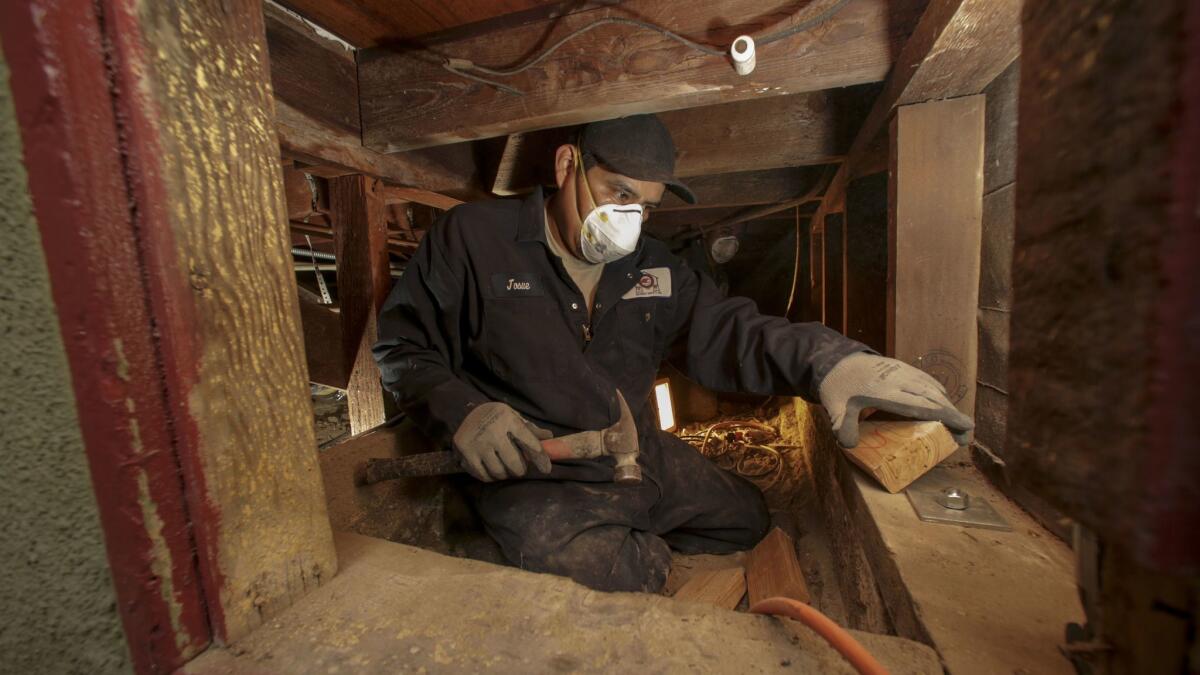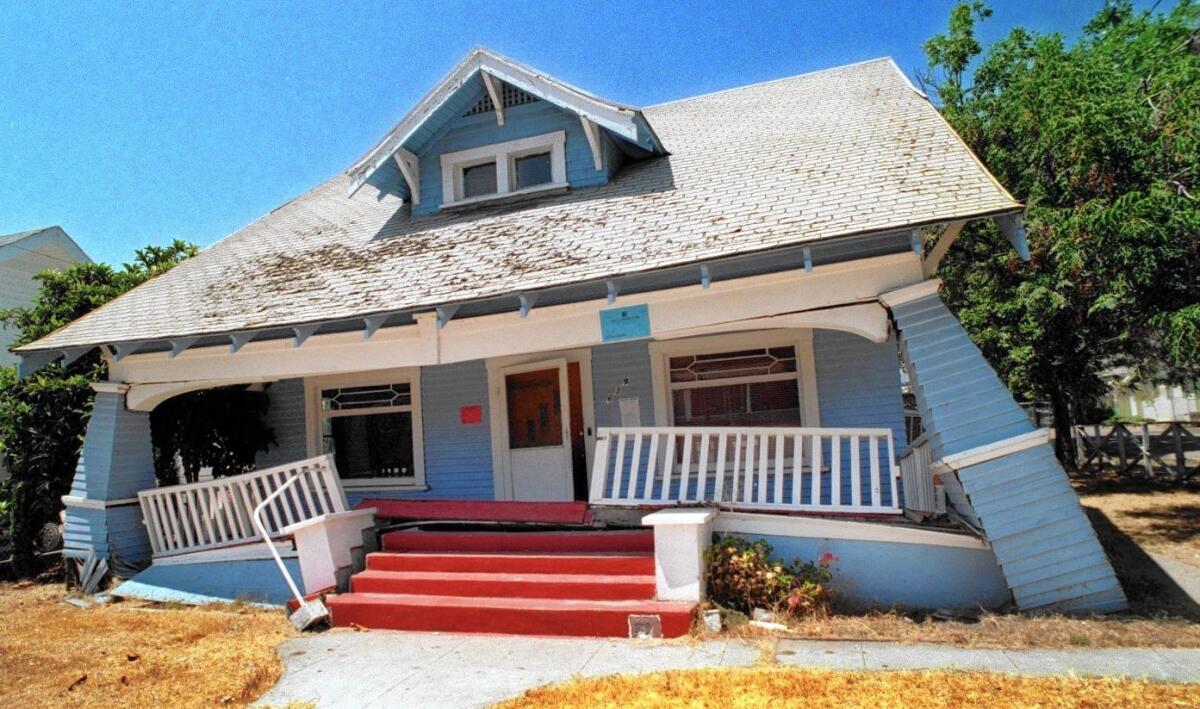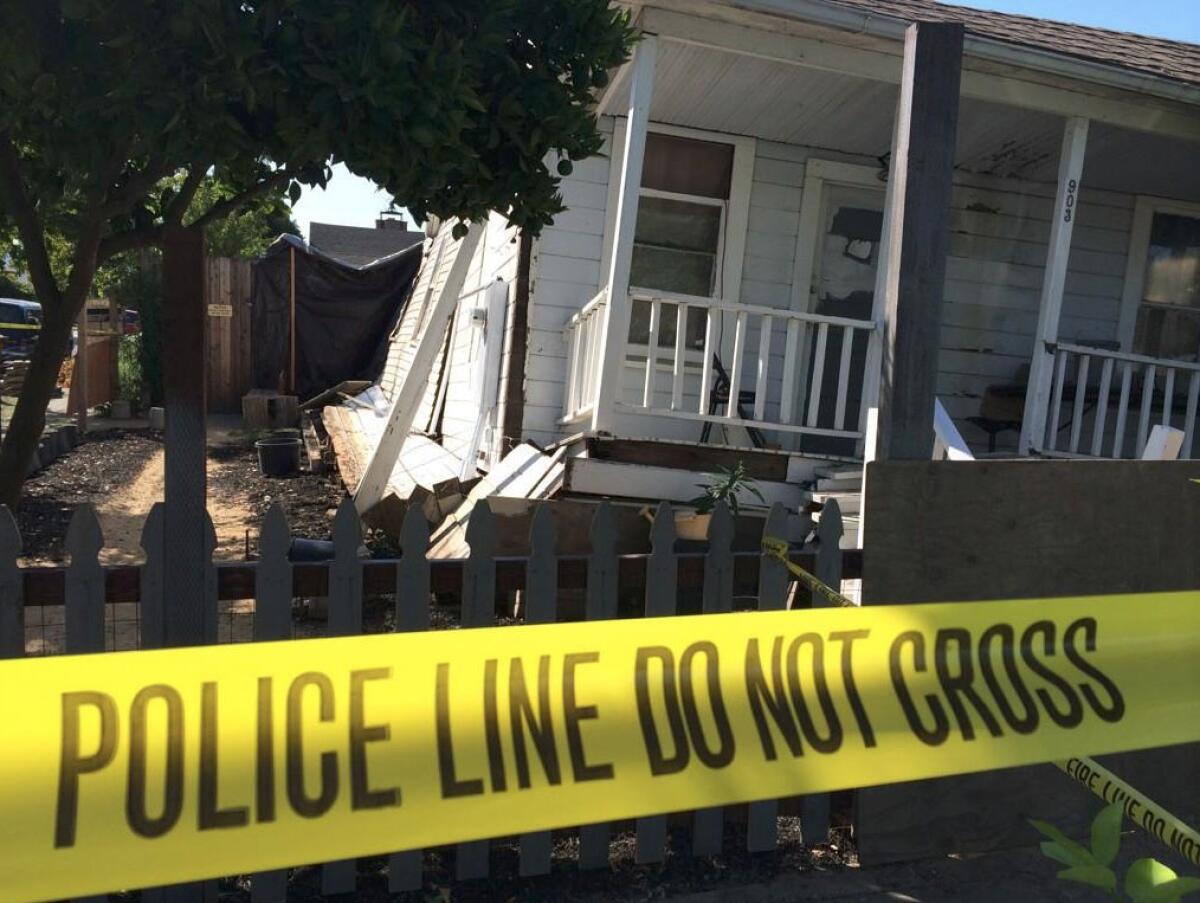Column: We can’t prevent the Big One, but we can give our homes a fighting chance against earthquakes

- Share via
Sorry to disappoint, but reliable science tells us there there is no such thing as earthquake weather. And although animals may pick up on a seismic wave that most humans don’t sense, the dog on your sofa and the cow in the pasture can’t predict earthquakes.
But I can.
I predict there’s going to be a big one.
I’ve never been more sure of it, thanks to a spring tour of the San Andreas fault with seismologist Lucy Jones, Southern California’s very own queen of quakes. That’s when I became aware of the unsettling fact that in a major temblor — for which we are statistically overdue — anyone standing where I was standing would be jolted about 30 feet as the ground shattered and shifted.

Bracing for the Big One
On that tour, Jones was trying to get city officials from various locales to upgrade seismic safety requirements and get better prepared for the inevitable Big One. In California, we all live in earthquake country, and in addition to death and injuries, transportation disruption and the possible cutoff of water and power services for months, the structural damage caused by a mega-jolt could force us out of our own homes.
Jones told me that the 1988 Pasadena earthquake, a 5.0, knocked her out of bed. I don’t live far from where she did at the time, so we got to talking about bracing and bolting.
My house was bolted, I told her, according to the general inspection report I got when I bought the place. But the structure is more than 70 years old, and I had no idea how securely it was fastened.
Related: The Times earthquake safety guide »
Jones suggested I call Seismic Safety, a retrofitting company in Pasadena. Over the years, she’s had Seismic inspect four houses she has lived in, and upgrades were done on three of them. Jones knows more about our vulnerability than just about anyone, and currently, she is bolted and braced, and she has earthquake insurance on top of that, as do I. So I did what I was told. I made the phone call.
Seismic Safety, which started as a foundation repair company in the 1950s, has focused on residential earthquake retrofitting since the 1970s. The owner, Ed Sylvis, is 87 years old and still goes to the office every weekday. He sent an inspector to my house and the verdict was soon rendered.
My house was indeed bolted to the foundation, but it wasn’t as earthquake-safe as it should have been. Like so many thousands of houses in California, mine was built when bolts were smaller, farther apart, and not well-placed for maximum security.
Making your house safer
“To say a house is bolted can mean any number of things, and people can get the wrong impression,” said Tom Pelletier, owner of The Foundation Works. “Since 1936 in L.A., everything had to be bolted, but there were major differences … and bolts can be few and far between.”
Seismic Safety also pointed out that I didn’t have any foundation plates, which are now in common use. They’re like metal claws, and they’re used to secure the wood to the concrete in places where there’s not enough room to use the more common anchor bolts.

But I had an even bigger problem, which is also very common.
The wooden studs in the crawl space of a house, between the top of the concrete foundation and the floor, form what are called cripple walls. Imagine a picket fence of 2x4s. In a strong earthquake, that fence can sway and give out, and the whole house could collapse right down to the dirt. It’s like kicking someone who falls to his knees.
“We saw damage like this in Napa,” Janiele Maffei, a civil engineer with the California Earthquake Authority, said of the 2014 earthquake that knocked people out of their homes for months. “That kind of vulnerability can be catastrophic, where the building comes off the foundation or falls whatever the height of the crawl space is. And it costs tens to hundreds of thousands of dollars to shore up the foundation.”
In his office, Sylvis and one of his longtime inspectors, Ken Compton, showed me a model of a house and explained how they brace cripple walls by fortifying them with sheets of plywood.
Each earthquake offers up a clinic on seismic engineering, said Sylvis and Compton, particularly big ones such as Sylmar in 1971 and Northridge in 1994. After the Northridge quake, they surveyed a Hancock Park house they had braced and bolted just before the quake, and it suffered far less damage than other homes on the same street. But by studying the location of surface cracks on the house, they refined the science of where exactly to get the most protection from bolting.
“Bracing and bolting is the best insurance you can get,” said Sylvis, who told me he doesn’t have earthquake insurance. He’s betting that his own work on his house is solid, and that the cost of earthquake damage repairs won’t be higher than the deductible on an insurance policy.
Nothing provides total protection
Not that you can make any structure completely earthquake-safe. Itzcik Weinstein of Weinstein Construction said his Sherman Oaks home was retrofitted by his own company but still absorbed nearly $250,000 worth of damage in the Northridge quake. He had earthquake insurance, so his loss was minimal.
And by the way, if you’re properly retrofitted, you may qualify for a discount on earthquake insurance.
Based on what I learned about my own house, I’d recommend having a seismic contractor do an inspection of any house before you buy. Bracing and bolting isn’t cheap — the tab generally runs from $3,000 to $7,000. But the state has been awarding thousands of grants to homeowners in certain ZIP Codes, and if you register and hit the jackpot, you could get $3,000 toward the cost of your retrofit.
You’ll have to wait until January for the next round of grants, but you should go to earthquakebracebolt.com, scroll to the bottom of the page, and sign up for updates and details about the next grant registration. (You should also go to latimes.com/quaketips for great information from our own earthquake guru, Rong-Gong Lin II, on how to make your house quake-safer and put a kit together).
If you want to brace and bolt now, without waiting for the next round of state grants, go online and find retrofitting companies that service your area, and ask for referrals. I’d recommend asking the contractor to show you before and after photos from under your house to make sure the work was completed. City inspectors have to sign off on the jobs, but you should make sure they crawl under the house and get dirty. I’ve heard accounts of inspectors, and contractors, cutting corners on occasion.
I got my hopes up that a lost treasure, or something of interest, might be found under my house. Pelletier said he once discovered some long-lost jewelry that apparently had been hidden by the family matriarch.
Can you really sleep easier?
One of the busiest companies out there is Alpha Structural, which specializes in the soft-story commercial and apartment building retrofits now mandated in Los Angeles. Senior Vice president Max Oliva said his crews have found animals of all kinds burrowing in crawl spaces, and once turned up some guns and knives.
The crew that did my house once found a bear cub living under a house in Sierra Madre. Sylvis said he crawled under a house in the Silver Lake area many years ago and made a startling discovery.
“There were people under there,” he said.
Doing what?
“Eating breakfast,” he said. “And the owners didn’t even know it.”
So what did he say to them?
“I said ‘Get the hell out. We’ve got work to do in here.’”
After my upgrade was completed, I dropped by Sylvis’ office to deliver the check.
“You’ll sleep better now,” he told me.
Yes, maybe just a little.
Get more of Steve Lopez’s work and follow him on Twitter @LATstevelopez
More to Read
Sign up for Essential California
The most important California stories and recommendations in your inbox every morning.
You may occasionally receive promotional content from the Los Angeles Times.











